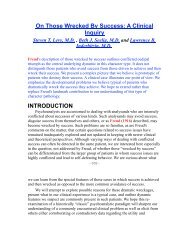A Sadomasochistic Transference - Beth J. Seelig, MD
A Sadomasochistic Transference - Beth J. Seelig, MD
A Sadomasochistic Transference - Beth J. Seelig, MD
Create successful ePaper yourself
Turn your PDF publications into a flip-book with our unique Google optimized e-Paper software.
and give up being bad. When she periodically found the courage to assert herself<br />
against mother (or analyst), this assertion took the form of raging tirades, which<br />
were later used as confirmation of her sense of badness. Another mechanism was<br />
critical in locking in her pathological tie to her mother: this was the narcissistic<br />
pleasure Miss T. took in feeling essential to the mother even if only as her phobic<br />
partner. Since she suffered from severe envy of all three siblings, any aspect of her<br />
relationship that gave her pride of first place—whether as mother's victim or<br />
phobic partner—was experienced as essential to her specialness.<br />
As Miss T. recalled it, mother interfered actively with any of her early efforts<br />
to form an attachment either to father or to her siblings, thus thwarting her<br />
attempts to extricate herself. She despaired of father as he was of no help, failing<br />
to intervene and thereby offering no alternative to the pathological motherdaughter<br />
bond. A new memory retrieved in the course of the analysis suggests the<br />
way in which triangulation was thwarted by Miss T.'s mother, a disruption father<br />
allowed. When Miss T. was four years old, her father took her on a rollercoaster.<br />
She sat on his lap and was thrilled by the experience. Upon their return home,<br />
however, when she ran to tell her mother about the exciting ride with Daddy, her<br />
mother went into a rage with her for having allowed her father to do such a<br />
dangerous thing. The affective valence of the experience was shifted 180 degrees:<br />
from pleasurable, erotically tinged excitement, to guilty humiliation-laden<br />
depression and suppressed rage. In this memory, father also failed her; he said<br />
nothing at all in response to his wife's scathing attack on their daughter. To turn to<br />
such a father to "make it up" would indeed be "ridiculous"<br />
- 981 -<br />
(it was the patient's longing for paternal rescue and her hopelessness at achieving<br />
it that were presaged in her initial dream). Her mother's message, as Miss T.<br />
interpreted it, was that she should be of one mind with her mother and also that<br />
she should not form a separate relationship with her father, as such a relationship<br />
would imperil the life-sustaining mother-daughter bond.<br />
In the analysis, Miss T. expected to be misunderstood, even while<br />
vociferously demanding that her analyst be an "analytic mirror." In essence, she<br />
was demanding that the analyst provide her with that empathic understanding of<br />
which she had felt deprived. When she perceived any failure of empathy on the<br />
part of her analyst, she felt entitled to unleash her intense aggression. However,<br />
when she thought that the analyst did indeed validate her account of events, she<br />
berated her for being so easily duped. The ease of regression and the intensity of<br />
the transference, which at times seemed to overwhelm Miss T.'s small remnant of<br />
observing ego, appeared to be related both to her distorted relationship with her<br />
mother and the resultant instability of the oedipal configuration. This instability<br />
manifested itself in a rapid shift from oedipal issues and object relations to




